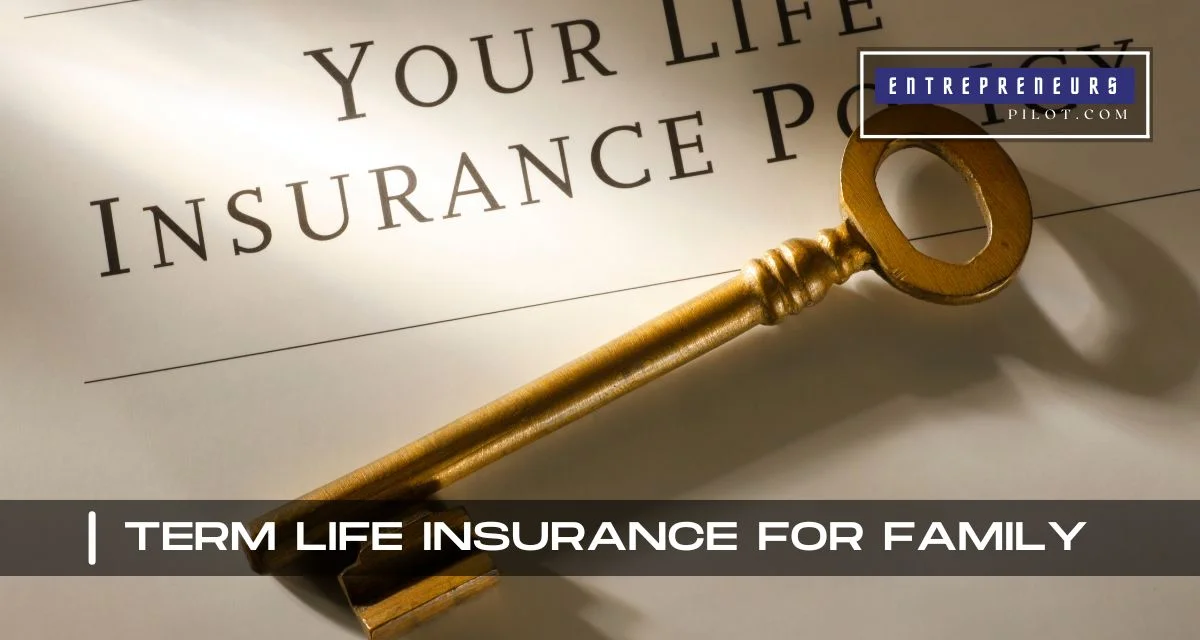Your family’s financial stability should not be left to chance, secure it with term life insurance!
Introduction: What are the differences between term life insurance for family and whole life insurance for family ?
Term life insurance for family and whole life insurance for family are two of the most common types of life insurance policies. Here are some key differences between the two:
- Coverage Period: Term life insurance provides coverage for a specific period of time, typically 10, 20, or 30 years. If the insured person dies during the term, the death benefit is paid out to the beneficiaries. Whole life insurance, on the other hand, provides coverage for the entire lifetime of the insured person.
- Cost: Term life insurance is generally less expensive than whole life insurance because it provides coverage for a shorter period of time. The premium for a term life insurance policy remains the same throughout the policy term. Whole life insurance premiums are usually higher than term life insurance but can be paid for the lifetime.
- Cash Value: Whole life insurance policies typically build cash value over time, which can be borrowed against or used to pay premiums. Term life insurance policies do not have cash value.
- Flexibility: Term life insurance policies are generally more flexible than whole life insurance policies, as they can be renewed or converted to a different type of policy. Whole life insurance policies are more restrictive in terms of making changes.
- Purpose: Term life insurance is often chosen for its affordability and to provide coverage for a specific need such as a mortgage or children’s education. Whole life insurance is chosen for permanent coverage and for its cash value feature that can be used for savings or as a source of loan.
It’s important to consider your specific needs and budget when choosing between term life insurance and whole life insurance.
Table of Contents
How do I know if my family needs permanent life insurance or if term life insurance is sufficient?
Whether your family needs permanent life insurance or term life insurance depends on your specific needs and financial situation. Here are some factors to consider when determining whether permanent life insurance or term life insurance is the best option for your family:
- Coverage Period: If your primary goal is to provide coverage for a specific period of time, such as until your children are grown or until your mortgage is paid off, term life insurance may be a better option. On the other hand, if you want to provide coverage for the entire lifetime of the insured person, permanent life insurance may be more suitable.
- Cost: Term life insurance is generally less expensive than permanent life insurance because it provides coverage for a shorter period of time. If cost is a major concern, term life insurance may be the better option.
- Cash Value: Permanent life insurance policies typically build cash value over time, which can be borrowed against or used to pay premiums. If you want to use your life insurance policy as a savings or investment vehicle, permanent life insurance may be a better choice.
- Future Needs: If you anticipate that your family’s needs may change in the future, such as the need for long-term care or estate planning, permanent life insurance may be a better option as it provides flexibility to adjust the death benefit or premium payments.
- Budget: Reviewing your budget and seeing if you have the capacity to pay for the higher premium of permanent life insurance or if you are comfortable with the lower premium of term life insurance.
It’s important to keep in mind that every family’s situation is unique and that what’s right for one family may not be right for another.
Are there any tax implications of different life insurance options for families?
Yes, there can be tax implications of different life insurance options for families. Here are a few things to consider:
- Death Benefit: The death benefit paid out to beneficiaries from a life insurance policy is generally tax-free.
- Cash Value: With some types of permanent life insurance policies, such as whole life or universal life, cash value can accumulate over time. The cash value may be subject to income tax if it is withdrawn or borrowed against.
- Premiums: Premiums paid for life insurance are generally not tax-deductible for individuals, but for some businesses, the premiums may be tax-deductible as a business expense.
- Estate Tax: In some cases, the death benefit from a life insurance policy may be included in the taxable estate of the deceased person. This can be mitigated by proper estate planning and by making sure the policy is structured and owned correctly.
- Trusts: If a life insurance policy is held in a trust, the death benefit paid out to the beneficiaries may be subject to different tax rules.
It’s important to keep in mind that tax laws are subject to change and that the tax implications of a particular life insurance policy may vary depending on your specific situation. It’s always best to consult with a tax advisor or insurance agent to determine the best option for you and your family.
- For Expert Financial Insights And Guidance, You Can Visit Our Sister Site – ArabsGeek.com Now!
- Curiosity Piqued? Dive Into the Most Captivating Financial Content by Visiting Our Homepage!
- Unlock Exclusive Business Opportunities! 🚀 Connect with Us Now at our Email: [email protected]!
How does the income and debt of a family affect the amount of life insurance coverage that is needed?
The income and debt of a family can have an impact on the amount of life insurance coverage that is needed. Here are some factors to consider:
- Income Replacement: If your family relies on your income to maintain their standard of living, you will want to ensure that your life insurance coverage is sufficient to replace that income. Your coverage should be enough to cover your family’s living expenses, such as mortgage payments, education costs, and everyday expenses.
- Debt Repayment: In the event of your death, your life insurance coverage can be used to pay off any outstanding debts, such as mortgages, car loans, and credit card balances. If you have a significant amount of debt, you may want to consider increasing your coverage to ensure that it is sufficient to pay off those debts.
- Saving for Future Expenses: Your life insurance coverage can also be used to save for future expenses such as children’s education, marriage expenses, and retirement. The higher your income, the more likely you are to have more future expenses and you may want to consider increasing your coverage to ensure that it is sufficient to cover these expenses.
- Paying Off Final Expenses: Your life insurance coverage can also be used to cover your final expenses such as funeral costs and medical expenses. The higher your income, the higher the final expenses may be, and you may want to consider increasing your coverage to ensure that it is sufficient to cover these expenses.
It’s important to consider your family’s specific needs and budget when choosing a life insurance policy. It’s also wise to consult with a financial advisor or insurance agent to determine the best option for you and your family. They can help you evaluate the current income and debt and develop a coverage plan that fit your family’s specific needs and budget.
Are there any options for life insurance that can be tailored to the specific needs of my family?
Yes, there are options for life insurance that can be tailored to the specific needs of your family. Some of these options include:
- Customizable term Life Insurance: This type of policy allows you to choose the coverage amount and term length that best fits your needs. You can also add riders, such as accidental death coverage or critical illness coverage, that provide additional protection for your family.
- Universal Life Insurance: This type of policy offers both death benefit protection and a savings component. The savings component can accumulate cash value over time, which can be used to pay premiums or increase the death benefit. The policy holder has more flexibility to adjust the coverage amount and premium payments, making it more tailored to the specific needs of the family.
- Whole Life Insurance: Whole life insurance is a type of permanent life insurance that provides death benefit protection and also builds cash value over time. The coverage amount and premium payments are fixed, making it easy to budget for, and the policyholder can borrow against the cash value if needed.
- Family Coverage: Family coverage is a type of life insurance that can be purchased to cover multiple family members, such as a parent and their children. This can be a cost-effective way to provide protection for multiple family members and can also help to cover expenses such as funeral costs.
- Child-specific Policies: If you have multiple children, you may want to consider taking out separate policies for each child. This can provide financial protection for each child in the event of their death and can also help to cover expenses such as funeral costs.
How do I ensure that my life insurance policy will provide enough coverage for my family in the event of my death?
There are several steps you can take to ensure that your life insurance policy will provide enough coverage for your family in the event of your death:
- Assess Your Family’s Needs: The first step in determining how much life insurance coverage your family needs is to assess their needs. Consider your current expenses, future expenses, and any outstanding debts. This will give you a good idea of how much money your family will need to cover their expenses in the event of your death.
- Review Your Coverage Regularly: As your family’s needs and financial situation change, it’s important to review your life insurance coverage and adjust it as needed. This will ensure that your family has enough coverage to cover expenses in the event of your death.
- Consult With A Financial Advisor: A financial advisor can help you determine how much life insurance coverage your family needs and can also help you choose the right type of policy for your needs. They can also help you review your coverage regularly, to ensure that your family is well protected.
- Consider Adding Riders To Your Policy: Some life insurance policies offer riders, such as accidental death coverage or critical illness coverage, that provide additional protection for your family. Consider adding these riders to your policy to ensure that your family is well protected.
- Research Different Life Insurance Options: There are different types of life insurance policies available such as term life insurance, whole life insurance, universal life insurance, etc. Research the different options available and choose the one that best fits your needs and budget.
Be honest and provide accurate information when applying for the policy. Misrepresenting your health status, occupation, or other details can lead to a policy being denied or not paying out when a claim is made.
By following these steps, you can ensure that your life insurance policy will provide enough coverage for your family in the event of your death. It’s important to keep in mind that every family’s situation is unique and that what’s right for one family may not be right for another.
How does the cost of life insurance vary for different types of policies and for different age groups?
The cost of life insurance can vary depending on a number of factors, including the type of policy and the age of the policyholder. Here are some ways in which the cost of life insurance can vary:
- Type of Policy: The cost of life insurance can vary depending on the type of policy. For example, term life insurance is generally less expensive than whole life insurance because it only provides coverage for a specified period of time.
- Age: The cost of life insurance generally increases as a person gets older. This is because older individuals are considered to be at a higher risk of death than younger individuals.
- Health Status: The cost of life insurance can also vary depending on the policyholder’s health status. Individuals who are in good health may be able to qualify for lower rates than those who have pre-existing health conditions.
- Coverage Amount: The cost of life insurance can vary depending on the amount of coverage needed. Generally, the more coverage a person needs, the more expensive the policy will be.
- Policy Length: The cost of life insurance can vary depending on the length of the policy. For example, a 10-year term policy will generally be less expensive than a 30-year term policy.
- Smoking Status: Smokers pay more for life insurance than non-smokers because they are considered to be at a higher risk of death.
It’s important to keep in mind that these are general guidelines, and the cost of life insurance can vary depending on the specific policy and the insurer. It’s always best to compare quotes from multiple insurers to find the best rate for your specific needs.
Pros Of Life Insurance
Cons Of Life Insurance
Conclusion: Term Life Insurance for Family
In conclusion, term life insurance is a valuable financial tool for families seeking to protect their financial future in the event of a tragedy. With its affordable premiums, flexible coverage options, and large coverage amounts, term life insurance can provide peace of mind and stability to families. However, it is important to consider the limitations of term life insurance, including its limited coverage and lack of cash value, when making a decision. It is crucial to thoroughly research and understand the options available, and to work with a knowledgeable insurance professional to determine the best policy for your family’s needs. With the right coverage in place, families can feel confident that their financial future is protected and secure.
FAQs: Term Life Insurance for Family
-
01. What is Term Life Insurance for Family?
Term Life Insurance for Family is a type of life insurance policy that provides financial coverage to the policyholder’s family in the event of the policyholder’s death. The policy is active for a specific term, typically ranging from 10 to 30 years, and pays out a lump sum to the beneficiaries in the event of the policyholder’s death during the term of the policy.
-
02. Who can apply for Term Life Insurance for Family?
Anyone who is 18 years or older and in good health can apply for Term Life Insurance for Family. The policyholder can choose their beneficiaries, typically their spouse and children, who will receive the death benefit if the policyholder dies during the term of the policy.
-
03. How does Term Life Insurance for Family differ from other life insurance policies?
Term Life Insurance for Family is different from other life insurance policies such as Whole Life Insurance, Universal Life Insurance, and Endowment Life Insurance in that it provides coverage for a specific term only. If the policyholder does not die during the term of the policy, the policy will simply expire without providing any benefits. On the other hand, other life insurance policies provide coverage for the policyholder’s entire lifetime and also accumulate cash value over time.
-
04. How much does Term Life Insurance for Family cost?
The cost of Term Life Insurance for Family depends on several factors such as the policyholder’s age, health status, and coverage amount. Typically, the premium for a Term Life Insurance policy is lower compared to other life insurance policies, making it a cost-effective option for families who want to secure their financial future.
-
05. How can I apply for Term Life Insurance for Family?
Applying for Term Life Insurance for Family is easy and straightforward. You can either go through a life insurance agent or apply directly through an insurance company. You will need to provide personal and medical information to determine your coverage and premium, and you can choose the coverage amount and term that best fits your needs and budget.











